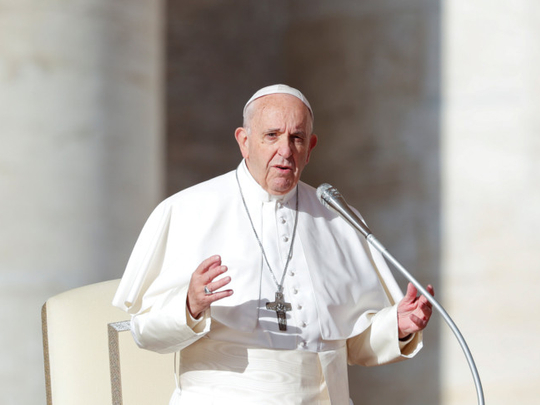
Compiled by Jay Hilotin, Web Editor
Dubai, UAE: A teenage Catholic who complains about the Holy Mass being boring — and that he gets nothing out of it — is no different from a mother who complains about football being boring, and that she gets nothing out of it.
This story, told by the Venerable Archbishop Fulton Sheen, points to a common denominator: A basic lack of understanding of the matter at hand.
But he proposes a simple solution. A person must make an effort — a sacrifice — to bring the knowledge of something from the past to find the present experience meaningful.
That’s how Arch. Sheen, one of the great Catholic evangelists of the 20th century, explained the meaning of the Mass in one of his 300 recorded sermons, on YouTube.
“You have to bring something to it (football game, an opera, Greek ruins, the Holy Mass), in order to understand it,” he said.
Here’s an explainer on the Mass:
What is it?
Formally, it's called the Most Holy Sacrifice of the Mass.
“Very simply,” Archbishop Fulton Sheen explained, “the Mass is reaching to Calvary. The continuation of Calvary.”
Catholics see the Mass — or "Eucharist" (Greek for thanksgiving) — as “the source and summit of the Christian life”, to which the other sacraments are oriented. Catholics believe the Mass is exactly the same sacrifice that Jesus Christ offered on the Cross at Calvary.
“In order to take part in it, you have to bring our little crosses," explained the Archbishop. "Our blessed Lord said: ‘Take up your cross daily and follow me.’ Everyone has a cross. Young students have the cross of spelling, mathematics, obedience to parents.”
“We bring our crosses and we plant them down alongside the Great Cross of Christ. We mass them altogether under Him. That is the Mass.”
The Catechism of the Catholic Church, defines the Mass as the faith's highest form of worship.
Where does the word 'Mass' come from?
It is derived from the concluding words of the Roman Rite Mass in Latin: “Ite, missa est” (Go, it is the dismissal), in used at least since the 6th century. The Latin word “missa” corresponds to the word “mission”. The word “dismissal” has come to imply a “mission.”
Missa also means "to be sent", and is the root of the English word "mission".
In modern times, the priest may also tell the congregation the Latin phrases, “Ite ad Evangelium Domini annuntiandum" (Go and announce the Gospel of the Lord)”, and “Ite in pace, glorificando vita vestra Dominum" (Go in peace, glorifying the Lord by your life).”
Both of these dismissals urge mass-goers are meant to go out in the world, sustained by the Eucharist they just received.
The “Mass”, therefore is not just a celebration on a Sunday or weekday or feast day — but a starting-point for a lifelong journey of witnessing among Christian.
The priest, the "alter-Christus" (the other Christ), sends forth his parishioners into the world to bring forth the peace and light of Christ. Adherents to the mass are also known as "Eucharistic people".
What does 'liturgy' mean?
Liturgy is a form of worship, from the ancient Greek (Greek: λειτουργία) leitourgia, or "litos ergos", which literally means "public service", or "work of the people".
The liturgy represents a communal response to and participation in the sacred through activity reflecting praise, thanksgiving, supplication or repentance.
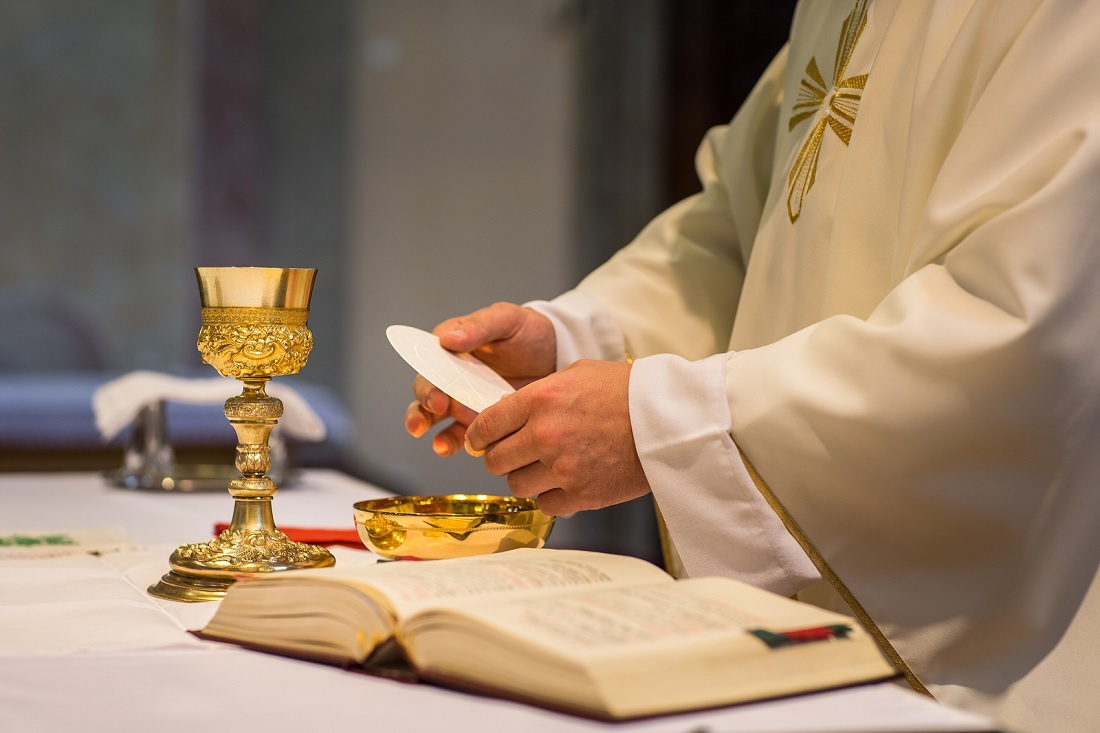
What does "sacrament" mean?
Catholics believe a sacrament as “an outward expression of an inward grace.” It is a ceremony or ritual regarded as imparting divine grace — such as baptism, Eucharist, confirmation, reconciliation, anointing of the sick, marriage, Holy orders. Many of the Catholic sacraments are administered in the framework of the Mass.
Sequence of the mass
In Western liturgy, the order of Mass generally consists of the following sections:
- 1. Procession, Introductory Rites
- 2. Sign of the Cross
- 3. Greetings (Taken from the writing of Paul, the Apostle)
- 4. Act of Penitence: Kyrie Eleison ("Lord, have mercy.")
- 5. Gloria ("Glory to God in the highest").
- 6. Opening Prayer: The Collect
- 7. Liturgy of the Word: First Reading, Psalms, Second Reading and Gospel reading
- 8. Homily: Typically the homilist (priest) prepares a "sermon" expounding on Scripture texts
- 9. Nicene Creed ("I believe in one God") or the Apostle's Creed
- 10. Prayer of the Faithful / General intercessions
- 11. Liturgy of the Eucharist: Preparation of the gifts (offering) and the altar (Sanctus, joining angels in giving praise to God)
- 12. Epiclesis: Consecration (transubstantiation)
- 13. Institution narrative
- 14. Anamnesis ("not forgetting", or memorial acclamation
- 15. Offering (priest joins the offering of the Mass to the sacrifice of Jesus)
- 16. Intercessory Prayer
- 17. Final Doxology: Great Amen.
- 18. Communion Rite: The Lord's Prayer ("Our Father")
- 19. Rite of Peace
- 20. Fraction Rite ("Agnus Dei", Lamb of God)
- 21. Distribution of Communion; Prayer after Communion
- 22. Announcements (if any)
- 23. Concluding Rites
- 24. Dismissal
1. Procession, Introductory Rites
The Mass begins with the entrance song. The celebrant, iin this case Pope Francis, and other ministers enter in procession and reverence the altar with a bow and/or a kiss. One of the altar servers, or a deacon, may carry the Gospel book which he will place on the altar.
Another altar server, called the "crucifer", carries a procession cross at the front of the procession. Other servers may carry blessed candles, incense, and a thurible (metal censer suspended from chains, in which incense is burned during worship services).
2. Sign of the Cross
Once the celebrant and servers are at the altar, all make the Sign of the Cross. For Catholics, the altar is a symbol of Christ at the heart of the assembly and so deserves special reverence.
3. Greetings
The celebrant extends a greeting to the gathered people, in words taken from Scripture.
4. Act of Penitence — 'Lord, Have Mercy'
At the very beginning of the Mass, the faithful recall their sins and place their trust in God's abiding mercy.
The Act of Penitence includes the "Kyrie Eleison", Greek for "Lord, have mercy." This litany recalls God's merciful actions throughout history. On Sundays, and special celebrations like Easter, in place of the customary Act of Penitence, from time to time the blessing and sprinkling of water to recall Baptism may take place.
5. Gloria
The Gloria, echoing the angels at the birth of Christ, starts with "Glory to God in the highest! Heaven and earth are filled with Your glory." In this ancient hymn, the congregation joins the heavenly choirs in offering praise and adoration to the Father and Jesus through the Holy Spirit.
6. The Collect
The Introductory Rites conclude with the Opening Prayer, also called the Collect, and gives a context for the celebration. The celebrant invites the gathered assembly to pray and, after a brief silence, proclaims the day's prayer.
7. Liturgy of the Word — Readings and Holy Gospel
Scripture readings. On Sundays and solemnities, there are three Scripture readings. The first reading is usually from the Old Testament. The second reading is from one of the New Testament letters.
The final reading is always taken from one of the four Gospels (Matthew, Mark, Luke and John).
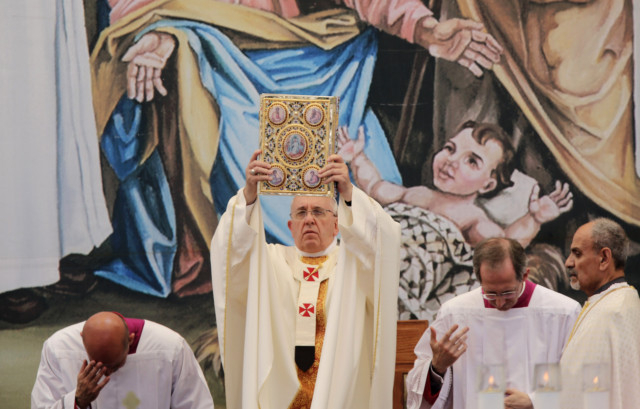
In the Liturgy of the Word, the Church feeds the people of God from the table of his Word.
The Scriptures are the word of God, written under the inspiration of the Holy Spirit. In the Scriptures, God speaks, leading the believers along the path to salvation.
The Responsorial Psalm is sung between the readings. The psalm helps the people meditate on the word of God.
The high point of the Liturgy of the Word is the reading of the Gospel. It is introduced by an acclamation of praise.
The Gospels tell of the life, ministry, and preaching of Christ. It receives several special signs of honour and reverence. The gathered assembly stands to hear the Gospel.
During most of the year, that acclamation is "Alleluia!" derived from a Hebrew phrase meaning "Praise the Lord!"
The celebrant priest (or deacon) reads the Gospel.
8. Homily
After the Scripture readings, the celebrant preaches the homily.
In the homily, the preacher focuses on the Scripture texts or some other texts from the liturgy, drawing from them lessons that may help the congregation to live better lives. It is usually a call to be more faithful to Christ's call to grow in holiness.
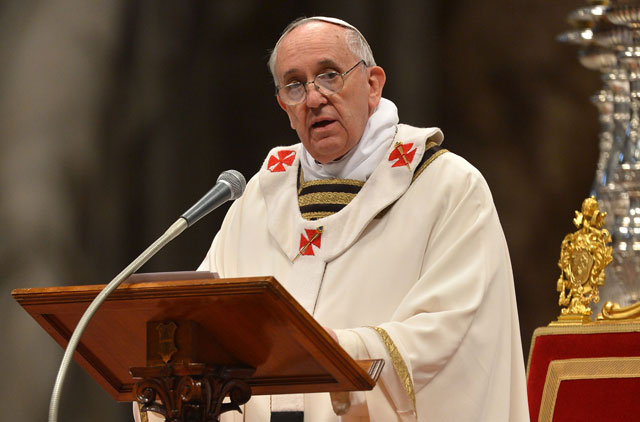
9. Nicene Creed
In most Masses, the Nicene Creed (an article of faith dating back to the Council of Nicea, in 325 AD) follows the homily. In certain instances, the Nicene Creed may be replaced by the Apostles' Creed (the ancient baptismal creed of the Church in Rome) or by a renewal of baptismal promises, based on the Apostles' Creed.
10. Prayer of the Faithful
The Liturgy of the Word concludes with the Prayer of the Faithful or the General Intercessions. The gathered assembly intercedes with God on behalf of the Church, the world, and themselves, entrusting their needs to the faithful and loving God.
11. Liturgy of the Eucharist
The Liturgy of the Eucharist begins with the preparation of the gifts and the altar. As the ministers prepare the altar, representatives of the people bring forward the bread and wine. Eucharist comes from the Greek “eukaristos”, which means thanksgiving, gratitude).
After the gifts and altar are prepared, the Eucharistic Prayer begins. This prayer of thanksgiving is the heart of the Liturgy of the Eucharist.
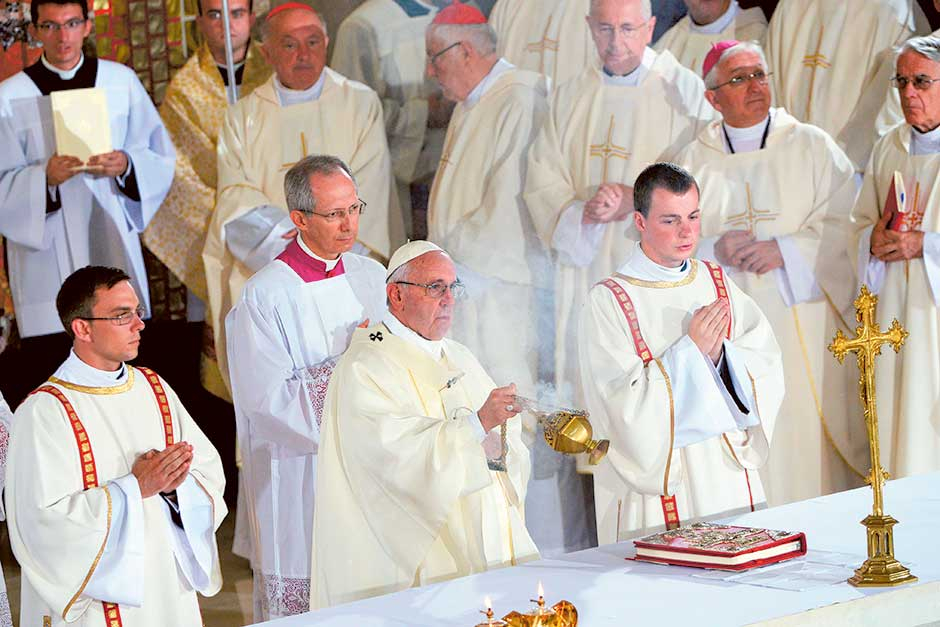
In this prayer, the celebrant acts in the person of Christ as head of his body, the Church. He gathers not only the bread and the wine, but the substance of our lives and joins them to Christ's perfect sacrifice, offering them to the Father.
After a brief introductory dialogue, the celebrant begins the Preface. The Preface tells of the wonderful actions of God, both throughout history and in our lives, giving thanks to God for all these things. The Preface concludes with the Sanctus in which the whole assembly joins the song of the angels giving praise to the Father in heaven
Catholics believe in “trans-substantiation”, which during the Mass, by invoking the power of the Holy Spirit, turn the bread and wine into the Body and Blood of Christ. The celebrant blesses and praises God for these gifts and places them on the altar.
In addition to the bread and wine, monetary gifts for the support of the Church and its work may be brought forward. This is optional, voluntary.
12. Epiclesis
This is a major part of the Eucharistic Prayer, in which the priest (Pope Francis) asks God to send the Holy Spirit on the gifts of bread and wine so that, through the power of the Holy Spirit, they may become the Body and Blood of Christ. Catholics believe this same Spirit will transform those attending the liturgy that they may grow in their unity with each other, with the whole Church, and with Christ.
13. Institution narrative
The Institution narrative, or story, comes with consecration. This part recalls the action of Christ on the night before his death. He gathered his closest disciples to share a final meal. In the course of this meal, he took the simple bread and wine, blessed them, and gave them to his friends as his Body and Blood. Catholics believe that in Eucharistic celebration, through the words of the priest and the action of the Holy Spirit, simple bread and wine, once again, become the Body and Blood of Christ.
14. Anamnesis
The Eucharistic Prayer continues with the anamnesis, literally, the "not forgetting." The people proclaim the memorial acclamation, recalling the saving death and resurrection of Jesus. The prayer continues as the celebrant recalls the saving actions of God in Christ.
15. Offering
In this part of the prayer, the priest joins the offering of this Mass to the perfect sacrifice that Jesus made on the cross. The priest offers this sacrifice back to God the Father in thanksgiving for God's abundant gifts, particularly the gift of salvation in Christ. The priest also prays that the Holy Spirit may come upon the faithful and by receiving the body and blood of Christ, they themselves may become a living offering to God.
16. Intercessory prayer
The intercessions follow. Confident in God's loving care, the gathered assembly makes this sacrifice on behalf of the living and the dead, for the leaders of the Church and for all the faithful.
17. Final Doxology
The Eucharistic Prayer concludes with the Final Doxology. The celebrant makes the prayer through, in, and with Jesus, in union with the Holy Spirit, and presents it to God the Father. The people respond with the “Great Amen” -- a joyous affirmation of their faith and participation in this great sacrifice of praise.
18. Communion Rite / The Lord's Prayer
The Communion Rite follows the Eucharistic Prayer, leading the faithful to the Eucharistic table.
The rite begins with the Lord's Prayer (or “Our Father”). Jesus taught this prayer to his disciples when they asked how to pray (Mt 6:9-13, Lk 11:2-4).
In this prayer, the people join their voices to pray for the coming of God's kingdom and to ask God to provide for our needs, forgive our sins, and bring us to the joy of heaven.
19. Rite of Peace
The Rite of Peace follows. The celebrant prays that the peace of Christ will fill our hearts, our families, our Church, our communities, and our world. As a sign of hope, the people extend to those around them a sign of peace, typically by shaking hands.
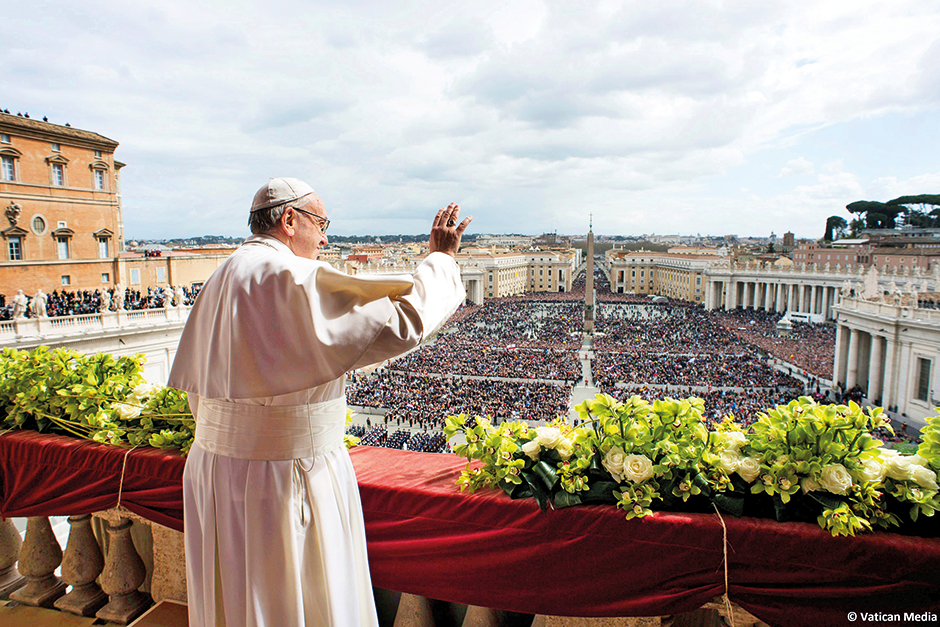
20. Fraction Rite: Breaking of the bread
In the Fraction Rite, the celebrant breaks the consecrated bread as the people sing the Agnus Dei or "Lamb of God." John the Baptist proclaimed Jesus as "the Lamb of God who takes away the sin of the world" (Jn 1:29).
The action of breaking the bread recalls the actions of Jesus at the Last Supper, when he broke the bread before giving it to his disciples. One of the earliest names for the Eucharistic celebration is the breaking of the bread.
Before receiving Communion, the celebrant and assembly acknowledge their unworthiness to receive so great a gift. The celebrant receives Communion first and then the people come forward.
Those who receive Communion should be prepared to receive so great a gift. They should fast (except for medicines) for one hour before receiving the Eucharist and should not be conscious of having committed serious sin.
Because sharing at the Eucharistic Table is a sign of unity in the Body of Christ, only Catholics may receive Communion. Those who do not receive Communion still participate in this rite by praying for unity with Christ and with each other.
The people approach the altar and, bowing with reverence, receive Communion. People may receive the Body of Christ either on the tongue or in the hand. The priest or other minister offers the Eucharist to each person saying, "The Body of Christ. The person receiving responds by saying, "Amen," word meaning, "So be it."
21. Distribution of Communion
As the people receive Communion, the communion song is sung. The unity of voices echoes the unity the Eucharist brings. All may spend some time in silent prayer of thanksgiving as well.
The Communion Rite ends with the Prayer after Communion which asks that the benefits of the Eucharist will remain active in our daily lives.
22. Announcements
When it is necessary, announcements may be made.
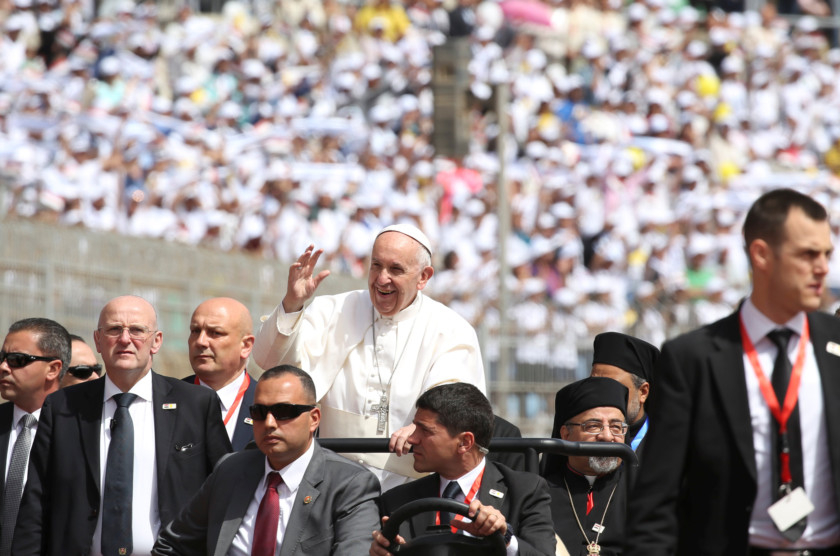
23. Concluding Rites
The celebrant blesses the people assembled. Sometimes, the blessing is very simple. On special days, the blessing may be more extensive. In every case, the blessing always concludes "in the name of the Father, and of the Son, and of the Holy Spirit." Catholics find their blessing in the triune God and in the sign of the cross.
24. Dismissal
After the blessing, the celebrant dismisses the people. The dismissal gives the liturgy its name. The word "Mass" comes from the Latin word, "Missa." At one time, the people were dismissed with the words "Ite, missa est," meaning "Go, you are sent."
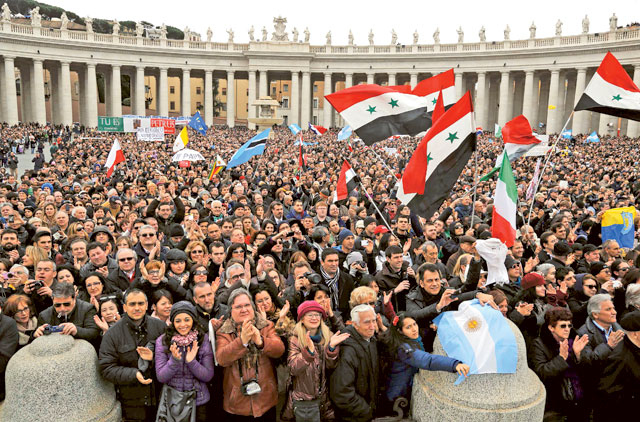
(Sources: Catechism of the Catholic Church, US Conference of Catholic Bishops, Video of Archbishop Fulton Sheen, Bishop Robert Barron on the Mass)








